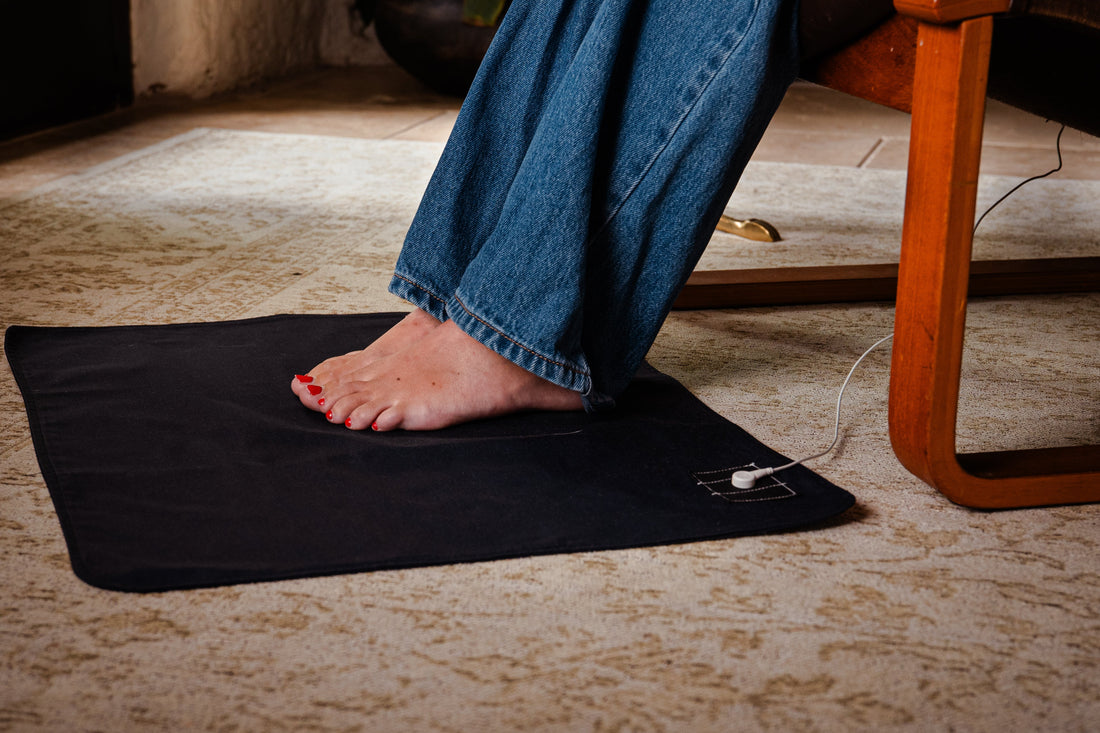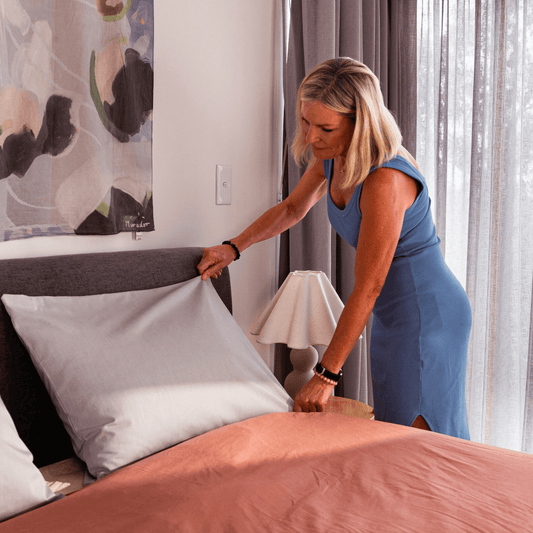
How Do Grounding Mats Work?
Grounding mats are becoming more common in homes, offices, and even bedrooms. They are promoted as a way to connect with the Earth’s energy without needing to go barefoot outside.
Many people use them for improved sleep, reduced stress, decreased pain, and faster recovery. But how do they actually work? This article explains grounding mats in simple terms, what science says about them, and how to use them safely.
What Are Grounding Mats?
A grounding mat is a flat mat made from conductive materials, usually carbon or silver threads, that allows an electrical connection between your body and the Earth. They are designed to mimic the natural act of walking barefoot on grass, sand, or soil. The mat is connected to the ground through a cord, either by plugging into the grounded port of a wall outlet or attaching it to a grounding rod placed in the soil outside.
Unlike an electric heating pad, a grounding mat does not use electricity to power itself. Instead, it simply provides a pathway for your body to discharge and receive electrons from the Earth. In short, it brings the outside grounding experience indoors.
The Science Behind Grounding Mats
The Earth carries a subtle negative electric charge. When your body makes direct contact with the Earth, electrons flow into the body and may help balance its internal electrical state. Grounding mats work on this principle by connecting you to the Earth through conductive surfaces and grounded cords.
One of the main scientific ideas behind grounding is that free radicals in the body, unstable molecules that can damage cells, may be neutralised by these electrons. This is why some researchers suggest grounding has antioxidant-like effects.
Beyond that, studies have reported changes in blood flow, inflammation, cortisol levels, and nervous system activity when people use grounding mats.
What Happens in the Body When Using a Grounding Mat?
When you use a grounding mat, the idea is that your body interacts with the Earth’s electric potential. Some studies suggest that this contact can reduce inflammation by calming the immune response. Others show potential improvements in circulation by lowering blood viscosity, which may help the blood flow more smoothly.
Grounding has also been linked to better stress regulation. Researchers observed changes in cortisol, the hormone that controls the body’s stress response, when people used grounding mats during sleep. This could help explain reports of better relaxation and improved sleep quality.
Another area of interest is the nervous system. Early findings suggest grounding may encourage a shift from the “fight or flight” mode to the “rest and digest” mode. This balance may help the body recover faster, sleep better, and manage daily stress.
What Research Says About Grounding Mats
Although grounding mats are still a developing area of study, several peer-reviewed papers have explored their potential effects.
- Inflammation and healing: Oschman, Chevalier, and Brown (2015) reviewed studies showing grounding may reduce chronic inflammation and speed up wound healing.
- Mood improvement: Chevalier (2015) published findings showing grounding could improve mood and lower stress levels.
- Blood flow and inflammation: Chevalier, Melvin, and Barsotti (2015) found that one hour of grounding improved circulation and reduced inflammation markers.
- Sleep studies: Ye et al. (2024) reported that rats using grounding mats showed longer REM and non-REM sleep, reduced wakefulness, and improved antioxidant activity.
These findings are encouraging, but it’s worth noting that many studies are small or preliminary. Larger human trials are still needed to confirm the full range of effects.
Practical Benefits of Grounding Mats
People often use grounding mats for everyday wellness. Some of the commonly reported benefits include:
- Better sleep: Many people say they fall asleep faster and stay asleep longer when using a grounding mat.
- Pain relief: Some studies suggest grounding may reduce chronic pain by lowering inflammation and improving circulation.
- Stress support: By influencing cortisol and calming the nervous system, grounding mats may help reduce feelings of stress or anxiety.
- Faster recovery: Athletes and active individuals sometimes use mats to support recovery after training or physical activity.
While not everyone may experience the same results, these potential benefits make grounding mats appealing as a simple wellness tool.
How to Use a Grounding Mat Correctly
Using a grounding mat is straightforward, but a few simple steps help ensure you get the most out of it:
- Placement: Mats can be placed under your feet while working at a desk, under your keyboard and mouse, or on your bed under the sheet.
- Direct contact: For best results, your skin should touch the mat. Thin cotton sheets or socks may still work, but bare skin contact is stronger.
- Time of use: Some use mats while sleeping, while others prefer daytime use when working or relaxing.
- Avoid mistakes: Make sure the cord is connected to a grounded outlet or grounding rod. Using a non-grounded connection won’t provide any effect.
Are Grounding Mats Safe?
Grounding mats are generally considered safe. They are not powered devices; they simply connect to the Earth’s natural charge. This means there is no current running through the mat. However, there are a few things to keep in mind:
- Medical devices: People with pacemakers or other implanted electronics should check with their doctor before using a grounding mat.
- Pregnant women: It is best for pregnant women to consult their healthcare provider before starting to use grounding mats, as a precaution.
- Proper connection: Always ensure your outlet or grounding rod is correctly grounded to avoid any safety issues.
For most people, grounding mats are a low-risk way to try earthing indoors.
Final Thoughts
If you are curious about grounding, a mat can be an easy way to start. They are simple to use, safe for most people, and may provide real support for better sleep, less stress, and improved recovery.
One option is getting our grounding stainless‑steel mat, which uses surgical‑grade stainless‑steel fibres woven into a soft, durable fabric. It is designed for consistent conductivity on both sides, backed by a 90‑day risk‑free trial and a three‑year warranty. These features give added peace of mind and make it a practical choice for anyone wanting to try grounding indoors.
As always, if you are pregnant or have a pacemaker or other medical device, it’s best to consult your healthcare provider before starting.







